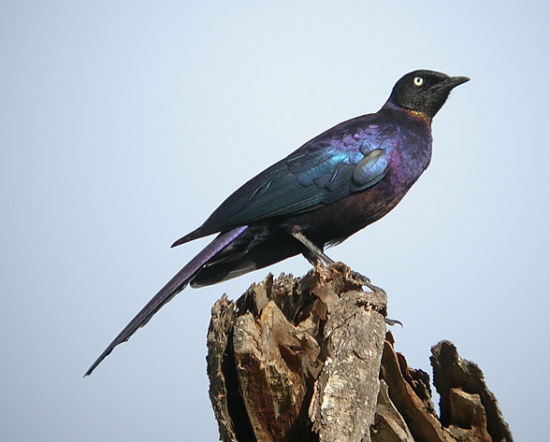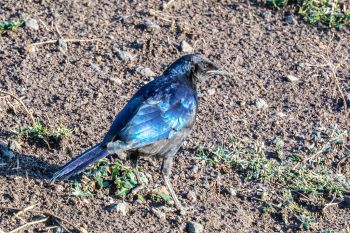Alternative name: Ruppell's Long-tailed Glossy Starling; Rüppell's Glossy Starling
- Lamprotornis purpuroptera
Identification
35cm. A large glossy starling with a long, graduated tail.
- Blue-green crown, chin and side of head with bronzy sheen
- Blue nape with purple sheen
- Blue back and mantle, purple rump
- Blue-green wings with dark barring
- Long, purple tail with prominent bars
- Blue-green throat and breast
- Purple rest of underparts with bronzy sheen in centre of belly
- Creamy white eye
- Black bill and legs
- aenocephalus is larger than nominate, has a longer tail, more violet on mantle, back and upper breast and less green in wings.
Sexes similar, the only difference is the mouth colour (pale pinkish in females, dark in males). Juveniles are matt black and have a dark brown eye.
Distribution
Found in East Africa from Eritrea south to Ethiopia, Uganda, Kenya and northern Tanzania.
Common in most parts of its range.
Taxonomy
Lamprotornis purpuroptera has two subspecies:1
- L. p. aeneocephalus
- Southeastern Sudan, South Sudan, northwestern Eritrea, and western Ethiopia
- L. p. purpuroptera
Forms a superspecies with Long-tailed Glossy-Starling and Meves's Glossy-Starling.
The scientif name has been spelled purpuropterus in the past.
Habitat
Grassland with some trees and bushes, often near water. Occurs up to 2000m. In Uganda also in cultivated land and urban areas.
Behaviour
Diet
Omnivorous. Feeds on fruit and insects and collects food scraps at camp sites.
Forages on the ground in pairs or small groups, hopping and running.
Breeding
A monogamous species, sometimes co-operative breeding recorded. The nest is placed in a tree hole or in an old Woodpecker hole. Lays 3 eggs.
Movements
Presumably a resident species, may also be nomadic.
References
- Clements, J. F., T. S. Schulenberg, M. J. Iliff, S. M. Billerman, T. A. Fredericks, B. L. Sullivan, and C. L. Wood. 2019. The eBird/Clements Checklist of Birds of the World: v2019. Downloaded from http://www.birds.cornell.edu/clementschecklist/download/
- Craig, A. J. F. and C. J. Feare (2020). Rüppell's Starling (Lamprotornis purpuroptera), version 1.0. In Birds of the World (J. del Hoyo, A. Elliott, J. Sargatal, D. A. Christie, and E. de Juana, Editors). Cornell Lab of Ornithology, Ithaca, NY, USA. https://doi.org/10.2173/bow.ruegls1.01
Recommended Citation
- BirdForum Opus contributors. (2024) Rüppell's Starling. In: BirdForum, the forum for wild birds and birding. Retrieved 27 April 2024 from https://www.birdforum.net/opus/R%C3%BCppell%27s_Starling





